
Katra Mosque, Murshidabad
Blog home / India's West Bengal: a cultural heritage that sets it apart
Forlorn palaces cling defiantly to their once-glorious pasts, and the half-ruined mosques and mildew-covered tombstones of East India Company employees are reminders of an era when Murshidabad was as large and rich as London. Now paddy fields and mango orchards have consumed most of what was once the flourishing capital of Bengal.
About 10 years ago, I composed a bucket list of places I wanted to visit in India after three decades of traversing all corners of the subcontinent. Murshidabad was always near the top of my list, and I wasn’t disappointed.
The Cossimbazar Rajbari is a fine example of European and Indian architecture Getting to Murshidabad is an entertaining journey in itself. The Hazarduari Express leaves Kolkata at the civilized hour of 6.50am. Baul singers, whose devotional songs reflect their blend of Hindu, Buddhist and Sufi beliefs, move between the carriages along with hawkers selling toys, snacks and colourful pieces of cloth. Chai sellers strain their brew through tannin-stained muslin sieves. My breakfast is two cups of their syrupy concoction and some freshly roasted peanuts.
Murshidabad’s story is one of conquest and commerce. It’s capture in 1757 by Robert Clive laid the foundations for British rule in India. Its silk merchants were among the richest traders in the world. When Clive plundered the Nawab of Murshidabad’s treasury, there was so much gold and silver in its vaults he expressed surprise at his own ‘moderation’ for not taking more than he did.
This is West Bengal at its best. Green and serene. A bend on a narrow road that winds its way through mango groves and paddy fields suddenly reveals an overgrown graveyard, a 17th-century mosque or a Jain trader’s palatial mansion.
With the exception of Kolkata and the tea-scented hill station of Darjeeling, West Bengal has been largely left off the itineraries of foreign travellers and tour companies. I’ve never understood why.
There are no monuments rivalling the Taj Mahal and its mostly flat riverine topography means there are no forts to dominate the horizon. What it does have is a rich cultural heritage that sets it apart from the rest of India. It also boasts one of the world’s largest mangrove forests known as the Sunderbans and home to the Bengal tiger. Its colonial past is evident in cities such as Kolkata and the remains of European settlements scattered along the Hooghly River.
The Bauls, those itinerant mystic minstrels who entertained me on the train to Murshidabad, are based around Santiniketan. The name of the town means 'abode of peace' and it was here that Nobel laureate, poet and artist Rabindranath Tagore founded the Visva Bharati university, where today many of the classes are conducted in the open air under vast spreading banyan trees.
Bengal’s temple architecture is also unique. A scarcity of stone means that the temples are covered in beautifully sculptured terracotta plaques, while the structures themselves are an intriguing mix of styles reflecting influences from Bengal, Orissa and the Mughal period.
There are a few of these temples scattered around Murshidabad as well as a Dutch cemetery and a beautifully restored Armenian church giving the town a strong multicultural mix.
For me, Murshidabad’s most magnificent building is also its most neglected, the 18th-century Sripur Palace. It was once the home of Krishna Kanta Nandy, who was rewarded with vast landholdings for saving the life of Warren Hastings, the future governor of Bengal. From the outside, the palace looked so forlorn I expected an empty shell. Instead, I discovered a majestic courtyard framed by a hundred pillars topped with lotus motifs and joined by exquisite carved archways brought all the way from Benares.
A wide balcony from the second storey looks down on an overgrown courtyard. Anywhere else this would be a major tourist attraction; instead, its wealthy Kolkata-based owners are happy for it to rot in the tropical heat and humidity because they have never forgiven the government for taking away their ancestral lands.
Sripur Palace’s days are clearly numbered, making it another reason why Murshidabad should be near the top of every traveller’s list to explore.
Words by historian, writer and former diplomat in India, John Zubrzycki. Learn more about his current trips with World Expeditions here.
About the writer
John Zubrzycki worked in India as a diplomat, consultant and foreign correspondent and has spent years searching out its hidden gems. He is a best-selling author and has written six books on India, the latest being the story of its princely states. He also writes feature articles for Australian and Indian news outlets. He has more than 40 years of travel experience in India and considers India’s east to be his favourite part of the subcontinent.